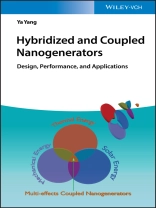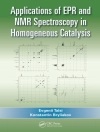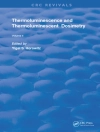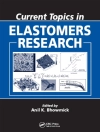A comprehensive guide to efficiently scavenge multi-energies from the surrounding environment to power some electronic devices and realize self-powered sensing!
With the advantages of high-integration level, low cost, and high-conversion efficiency, hybridized nanogenerators have many potential applications in multi-energy scavenging and sensor fields. This book offers a comprehensive review of the design, performance, and applications of hybridized and coupled nanogenerators. The authora noted expert on the topicexplores the various new hybridized and multi-effects coupled nanogenerators.
The book examines the current approaches of improving electric generation performance and offers an introduction to the applications of hybridized nanogenerators in energy harvesting and sensing. This technology has proven to be highly applicable in multi-energy scavenging and self-powered sensor fields. This book includes:
- Examines the potential applications of hybridized and coupled nanogenerators in multi-energy scavenging and sensor fields
- Covers the principles of device design
- Explores the most current approaches to improve performance
- Reviews various multi-effects coupled nanogenerators and their potential applications
Written for materials scientists, engineering scientists, electronics engineers, bioengineers, sensor developers, and sensor industry professionals, This book is a guide to hybridized and coupled nanogenerators that achieve the maximum utilization of multi-type and stable energies.
Jadual kandungan
Forewords xi
Preface xiii
1 Overview 1
1.1 Introduction 1
1.2 Hybridized Nanogenerators 2
1.2.1 Hybrid Energy Cells 2
1.2.2 Electromagnetic–Triboelectric Hybridized Nanogenerators 4
1.2.3 Other Hybridized Nanogenerators 6
1.3 Coupled Nanogenerators 9
1.3.1 Pyroelectric and Photovoltaic Coupled Nanogenerators 10
1.3.2 Multi-effects Coupled Nanogenerators 10
1.4 Applications 13
1.5 Conclusion and Prospects 14
References 15
2 Wind-Driven Triboelectric Nanogenerators 19
2.1 Introduction 19
2.2 Conventional Wind Harvester 19
2.2.1 Working Mechanisms and Devices Structure 19
2.2.2 Applications 21
2.3 Triboelectric Nanogenerators for Scavenging Wind Energy 21
2.3.1 Fundamental Modes and Structure 21
2.3.1.1 Vibrating Plate-Based TENGs 21
2.3.1.2 Enhanced Plate-Based TEGs 22
2.3.1.3 Elasto-aerodynamics-Driven TENGs 25
2.3.1.4 Others 25
2.3.2 Materials 27
2.3.2.1 Cellulose 27
2.3.2.2 Metal 29
2.3.2.3 Polymer 30
2.3.2.4 Nanoparticle and Nanowire 31
2.3.3 Performance 33
2.3.3.1 Mechanical Behavior 33
2.3.3.2 Electrical Output 37
2.3.4 Applications 41
2.3.4.1 Self-Powered Printer 41
2.3.4.2 Wind Gauging System 42
2.3.4.3 Polarization of Ferroelectric Materials 43
2.3.4.4 Self-Powered Wearable Electronics 43
2.3.4.5 Others 46
2.4 Comparison 52
2.5 Conclusion 53
References 53
3 Electromagnetic–Triboelectric Hybridized Nanogenerators 59
3.1 Introduction 59
3.2 Working Mechanisms 59
3.3 Hybridized Devices Structure and Working Mechanisms 61
3.3.1 Shared-Electrode-Based EMG–TENG 61
3.3.2 Rotating-Disk-Based EMG–TENG 61
3.3.3 Spring-Based EMG–TENG 64
3.3.4 Stretchable EMG–TENG 66
3.3.5 Others 67
3.4 Materials 73
3.4.1 Glass Fibers/Silver Nanowires 74
3.4.2 Composite Materials 74
3.4.3 Materials with Rough Structures 74
3.4.4 Others 75
3.5 Performance 76
3.5.1 Conjunction Manipulation 76
3.5.2 Output Characteristics 77
3.6 Applications 84
3.6.1 Powering Electronic Devices 85
3.6.2 Self-Powered Wearable Electronics 86
3.6.3 Others 87
3.7 Summary and Perspectives 90
References 91
4 Other Hybridized Nanogenerators 97
4.1 Introduction 97
4.1.1 Nanogenerators for Harvesting Solar Energy 97
4.1.2 Nanogenerators for Harvesting Electrochemical Energy 101
4.2 Hybridized Photoelectric and Piezoelectric Nanogenerator 107
4.2.1 Typical Materials and Structure Design 110
4.2.2 Principles 110
4.2.3 Applications and Performances 115
4.3 Hybridized Photoelectric and Triboelectric Nanogenerator 116
4.3.1 Materials and Fabrication 116
4.3.2 Principles and Performances 116
4.3.3 Applications 119
4.4 Hybridized Photoelectric and Pyroelectric Nanogenerator 122
4.4.1 Materials and Structure Design 122
4.4.2 Principles and Applications 122
4.4.3 Performances 126
4.5 Conclusions and Prospects 128
References 128
5 Hybridizing Nanogenerators and Sensors 133
5.1 Introduction 133
5.2 Materials 133
5.2.1 Organic Materials 133
5.2.2 Inorganic Materials 134
5.3 Design of Self-Powered Sensors 137
5.3.1 Pressure Sensors 137
5.3.2 Strain Sensors 140
5.3.3 Temperature Sensors 142
5.3.4 Photodetectors 144
5.3.5 Magnetic Sensors 147
5.4 Performance 148
5.4.1 Sensitivity 148
5.4.2 Response Speed 154
5.4.3 Stability 157
5.5 Applications 162
5.5.1 Touch and Motion Detection 162
5.5.2 Strain Detection 163
5.5.3 Temperature Detection 166
5.5.4 Image Sensor 166
5.6 Conclusion and Prospects 168
References 170
6 Hybridizing Nanogenerators and Energy Storage Devices 173
6.1 Introduction 173
6.2 Working Mechanisms 177
6.2.1 Piezoelectric Nanogenerator-Based Energy Storage Devices 177
6.2.1.1 PENG-Based Li-ion Batteries 177
6.2.1.2 PENG-Based Supercapacitors 178
6.2.2 Triboelectric Nanogenerator-Based Energy Storage Devices 180
6.2.2.1 TENG-Based Lithium-Ion Batteries 180
6.2.2.2 TENG-Based Supercapacitors 186
6.3 Materials 188
6.3.1 Typical Piezoelectric Materials 188
6.3.2 Typical Triboelectric Materials 191
6.3.3 Materials for Lithium-Ion Batteries 194
6.3.4 Materials for Supercapacitors 196
6.4 Devices Structure and Design 198
6.4.1 Piezoelectric Nanogenerator-Based Energy Storage Devices 198
6.4.2 Triboelectric Nanogenerator-Based Energy Storage Devices 201
6.5 Performance 203
6.5.1 The Charging/Discharging Performance of Lithium-ion Batteries and Supercapacitors Based on Piezoelectric Nanogenerators 204
6.5.2 The Charging/Discharging Performance of Triboelectric
Nanogenerator-Based Lithium-Ion Batteries and
Supercapacitors 205
6.6 Applications 209
6.6.1 Powering Electronic Devices 209
6.6.2 Wearable/Portable Electronics 211
6.6.3 Other Applications 212
6.7 Conclusions and Prospects 212
References 214
7 Pyroelectric and Thermoelectric Nanogenerators 219
7.1 Introduction 219
7.2 Working Mechanisms 220
7.2.1 Pyroelectric Nanogenerators 220
7.2.2 Thermoelectric Nanogenerators 222
7.2.3 Comparison of Pyroelectric and Thermoelectric Nanogenerators 222
7.3 Progress of Pyroelectric Nanogenerators 223
7.3.1 Typical Pyroelectric Materials 223
7.3.2 Structure Design 227
7.3.3 Performance of Pyroelectric Nanogenerators 231
7.3.4 Applications for Sensing and Electrochemistry 235
7.4 Progress of Thermoelectric Nanogenerators 238
7.4.1 Typical Thermoelectric Materials 238
7.4.2 Structure Design 241
7.4.3 Thermoelectric Performance 245
7.4.4 Applications in Various Fields 247
7.5 Conclusions and Prospects 250
References 252
8 Photovoltaic–Pyroelectric Coupled Effect Nanogenerators 259
8.1 Introduction 259
8.2 Basic Principle 260
8.2.1 Pyroelectric Effect 260
8.2.2 Photovoltaic Effect 261
8.2.3 Photovoltaic–Pyroelectric Coupled Effect 262
8.2.4 Temperature Dependence of Photovoltaic–Pyroelectric Coupled Effect 265
8.3 Materials 266
8.3.1 Zn O Nanowires 266
8.3.2 BTO Materials 268
8.3.3 BFO Materials 268
8.3.4 Other Materials 269
8.4 Device Design 270
8.4.1 Vertical Structure 270
8.4.2 Planar Structure 271
8.5 Performance 272
8.5.1 Output Electric Signals 272
8.5.2 Resistance 273
8.5.3 Comparison of Vertical- and Planar-Structured Nanogenerators 275
8.5.4 Temperature Dependence 277
8.6 Applications 278
8.6.1 Common Photodetection 279
8.6.2 Image Photodetection 281
8.7 Conclusions and Prospects 286
References 287
9 Multi-effects Coupled Nanogenerators 293
9.1 Introduction 293
9.2 Materials 294
9.2.1 Semiconductors 294
9.2.2 Inorganic Ferroelectrics 296
9.2.3 Polymeric Ferroelectrics 297
9.3 Device Design and Working Principle 298
9.3.1 Electrode/Bulk Semiconductor/Electrode Structure 298
9.3.2 Electrode/Heterojunction/Electrode Structure 302
9.3.3 Electrode/Ferroelectrics/Electrode Structure 303
9.3.4 Other Structures 306
9.4 Performance 310
9.4.1 Output Characteristics for Harvesting Thermal and Light Energies 310
9.4.2 Output Performance for Scavenging Thermal and Mechanical Energies 315
9.4.3 Output Characteristics for Harvesting Light and Mechanical Energies 315
9.4.4 Output Characteristics for Harvesting Thermal, Light, and Mechanical Energies 316
9.5 Applications 320
9.5.1 Energy-Storage Device Charging 320
9.5.2 Electrics Powering 322
9.5.3 General Sensing 322
9.5.4 Multifunctional Sensing 323
9.5.5 Image Sensing 326
9.6 Conclusions and Prospects 331
References 331
10 Coupled Nanogenerators for New Physical Effects 337
10.1 Introduction 337
10.2 Pyro-Phototronic Effect 338
10.2.1 Introduction 338
10.2.2 Possible Semiconducting Materials 338
10.2.3 Applications 339
10.3 Ferro-Pyro-Phototronic Effect 341
10.3.1 Introduction 341
10.3.2 Possible Ferroelectric Materials 341
10.3.3 Applications 342
10.4 Thermo-Phototronic Effect 346
10.4.1 Introduction 346
10.4.2 Possible Thermoelectric Materials 346
10.4.3 Applications 347
10.5 Conclusions and Prospects 350
References 352
Index 357
Mengenai Pengarang
Ya Yang, Professor Beijing Institute of Nanoenergy and Nanosystems, Chinese Academy of Sciences, Beijing, China School of Nanoscience and Technology, University of Chinese Academy of Sciences, Beijing, China. Prof. Ya Yang has developed various new hybridized and multi-effects coupled nanogenerators, opening up the new principles of the device design and coupled effects, and the new approaches of improving output performances of energy-related devices. His main research interests focus on the field of hybridized and coupled nanogenerators for energy conversion, self-powered sensing, and some new physical effects. He has published more than 170 SCI academic papers in Science Advances and other journals. These papers have been cited by more than 10000 times, and the corresponding H-index is 60 (web of science). Prof. Yang is the editorial committee member of i Science, Nano-Micro Letters and some other journals.Details can be found at: http://www.researcherid.com/rid/A-7219-2016.












